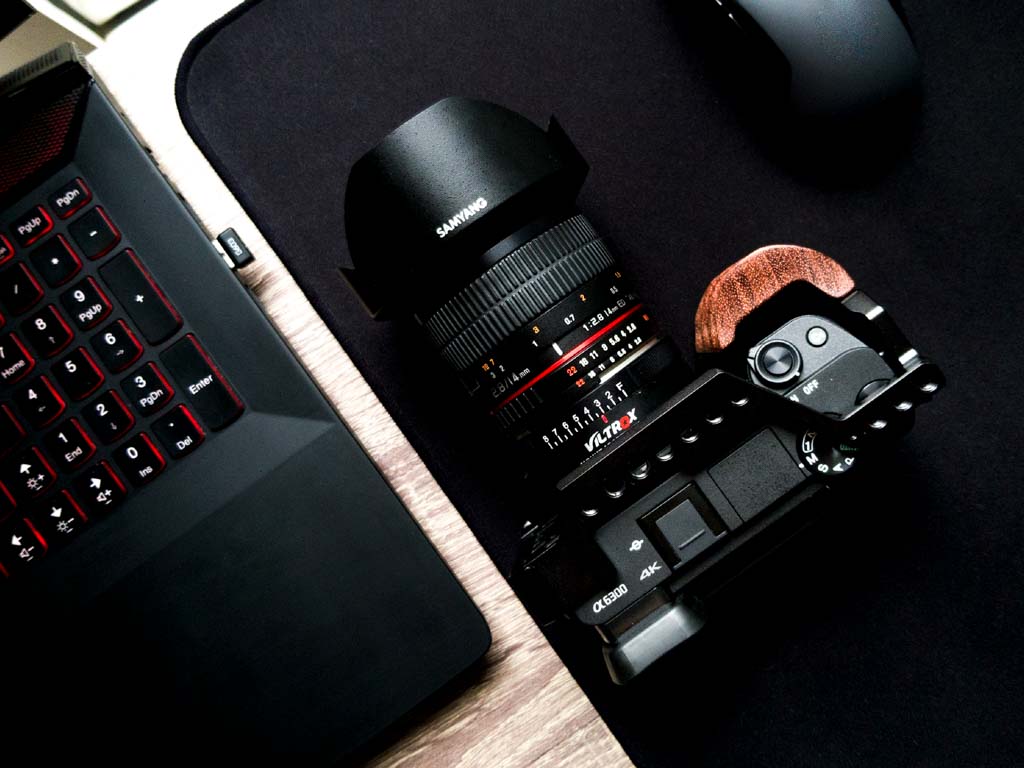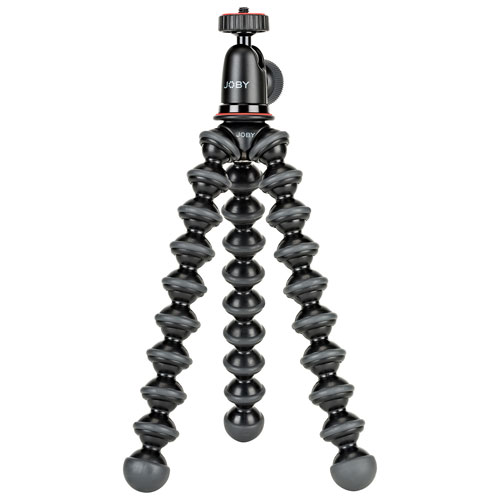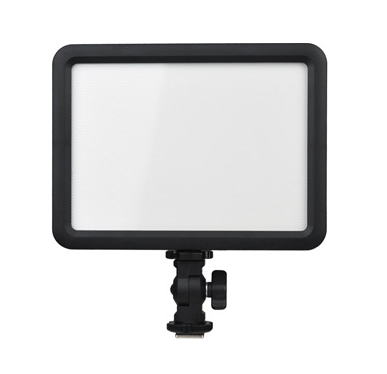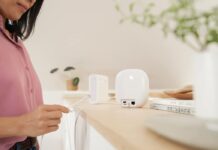
It’s been interesting to see how quickly the world made the pivot to online meetings and meetups over the old in-person kind. Personally, it feels like forever since I sat in room with a group of people who weren’t my family! If you’re feeling like a online meeting pro at this point, maybe it’s time to get a bit adventurous—up your meeting game—and try to connect your camera to your computer to show the world the best possible version of yourself.
For better or worse, online get-togethers have become the new norm and I think we’ve all gotten a little bit more savvy at getting ourselves set up in time so there’s a lot less ‘John—are you there?’ moments. Think of it this way; you are now a broadcaster, as this Forbes article points out. And if you’re in a position of influence, or hope to be, having the best feed in the “room” might be important to you.
Right now, the vast majority of people are just going to default to using the camera on their computer, but it is possible to connect most cameras to your computer via USB and take advantage of their dedicated image-making capabilities. If you already own a good quality camera, it would seem a shame to leave it sitting there gathering dust while it could be put to good use, bringing you to the world in all your lockdown-hair glory!
Unfortunately there is no one-size-fits-all solution to using your camera as a webcam so I’m going to run through a range of options based on the various models and manufacturers. There are also some different requirements for PC and Mac users, and I’ll point those out along the way.
READ MORE: What kind of computer do you need to work from home?

Using your Canon camera as a webcam
Canon recently released new software that is specifically designed to allow you to connect your Canon camera to your computer and use it as a webcam. The EOS Webcam Utility Beta works with select EOS Interchangeable Lens Cameras (ILC) and PowerShot cameras. The program is designed to work with, for example, the EOS Rebel T7, the EOS Rebel SL3, the EOS M50, and the PowerShot G7x Mark III. Unfortunately it doesn’t work with all current Canon models, and you can find the full list on this Canon support page. Once you’ve installed the software all you need to do is connect your camera to your computer via USB an you’re ready to go. The software is available to both Mac and PC users.
Using your Nikon camera as a webcam
Nikon has also joined the webcam-software bandwagon with their Webcam Utility which is available for both Windows and iOS. The download pages give you the system requirements, and these are worth looking at because not all web conferencing apps are necessarily supported, and in the case of iOS machines Safari is not supported. Also under the ‘System Requirements’ you’ll find the list of supported cameras, which is the same whether you’re using Mac or PC. Installation instructions are listed too, and they look totally straightforward.
If you are using a Nikon camera that is not compatible with the Webcam Utility program, then you might want to try the options outlined below, depending on your OS.
PC users
For PC users there are some third party software solutions that you can download and install. You will also need a USB cable or a HDMI cable in order to connect your camera to your computer. A HDMI cable will give the best results, but you will also need a video capture device like the Wiistar HDMI video capture card. The cheapest solution is a combination of two programs: digiCamControl and OBStudio, both of which are free and open source. An easier option is SparkoCam which is a paid-for application which allows you to use either a DSLR or mirrorless camera by Canon or Nikon as a webcam. Please note however that it does not work for all models! You can find the full list of compatible models on the SparkoCam homepage.
Mac users
Mac users will need to download and install the Ecamm Live software or OBStudio. You may be able to use a video capture device like the Wiistar mentioned above, but support for Nikon DSLRS is extremely limited—if you have a D5100 or D7100 you’re in luck.
Using your Sony camera as a webcam
PC users
If you are a Sony camera owner and PC user running Windows 10, you can use the latest version of the Sony Imaging Edge Webcam software to setup your camera as a webcam. 35 Sony cameras are compatible with the new software, including the newly announced A7S III. The RX100 IV, RX100 V, RX100 VI and RX100 VII are also compatible, as well as the RX10 IV. You can see the full list of compatible models here. All you need in terms of hardware is the standard micro-USB to USB cable to connect the camera to your computer. If you do have any trouble getting a feed from your camera to the computer screen, try using a different cable.
Mac users
If you’re a Mac user and you want to use your Sony camera as a webcam then there is only one option available to you; a video capture device like the aforementioned Wiistar capture card. This will work for any Sony camera that has a HDMI output port. Aside from the video capture device you’re going to need a micro-HDMI to full-size HDMI cable. On the plus side, this setup works for both Mac and PC. On the downside, it’s not particularly cheap. Also, you may find it difficult to even buy a video capture device right now as so many people are getting into video streaming.
Using your Fujifilm camera as a webcam
Fujifilm users who want to use their cameras as a webcam have a few options. The easy option is the Fujifilm Webcam software, which you can download here. However it only works for the X-T4, X-T3, X-T2, X-H1, X-T200, X-A7, X-Pro2 and X-Pro3, as well as the GF-X cameras, and it is only available to PC users. The other option, whether Mac or PC, is to use a video capture device. Mac users also have a purely software-based solution. You’ll need the CameraLive and CamTwist apps, and you’ll also need to copy and paste some code into the Terminal app. It’s really not that complicated, and if you’re interested in giving it a shot I suggest you check out this video.
READ MORE: Fujifilm’s latest cameras are aimed at everyone, including you.
Using your Panasonic camera as a webcam
There is no proprietary software solution for Panasonic cameras, so the only option is to connect your camera to your computer with a HDMI cable via a video capture device like the Wiistar HDMI video capture card and install streaming software like OBStudio.
Using your GoPro as a webcam
Using an action camera, like the latest GoPro Hero8, as a webcam requires a video capture device, whether you’re using a Mac or PC.
Using your camcorder as a webcam
Many camcorders are designed to be used for video streaming, and are perfect to use as webcams, right out of the box. Sony has posted a full article on their website that describes how to use a Sony camcorder as a webcam using USB Streaming. The article does point out that not all Sony camcorders have a USB Streaming port, and users should consult their instruction manual.
I’m starting to wonder whether camera manufacturers are now regretting not having put more thought into the possibility that end-users might want to use their cameras as webcams. As it stands it looks like Canon is the industry leader in this respect, and has done a fantastic job in creating the EOS Webcam Utility Beta, which will give many Canon users a simple way to turn their camera into a webcam.
Additional accessories

In order to set yourself up as a bone fide streaming pro, you are going to need more than just your camera and the connection method outlined above. Your also going to need a way to mount your camera at eye level to give your meeting mates the optimum view. Of course you could use a pile of books to accomplish the task, but I suggest you go out and pick up a proper tripod. Your best option, particularly if space is limited is to use a small and light, flexible tripod like those from Joby. They are so easy to use and set up, and they’re also perfect to carry with you when you travel.
Better audio
If you want to take things to the next level you can add an external microphone to improve the audio quality of your live feed. This Rode VideoMicro compact microphone has tonnes of great reviews from satisfied users.
Broadcasting better audio really is one of the best things you can do to improve your presence on a video call so I encourage you to do some more research on this one, regardless of the camera you are using to capture video.

Light source
Finally, if you want top marks for your streaming video quality, think about lighting. Your best default option is window lighting, but depending on the time of day and the room you are using this may not always be a practical option. The alternative is to use something like this Godox LED light panel. Proper LED light sources are great because they are really easy to set up and they can make such a huge difference. They’re also efficient, cheap to run and safe to use because they don’t heat up like tungsten bulbs do. You can usually mount them in the hot shoe of your camera so you don’t even need a light stand.
I hope you’re feeling more confident about using your DSLR, mirrorless or point and shoot camera as a webcam. If you have questions for me, or any tips or tricks you want to share, please feel free to do so in the comments below!




Should have checked the support page 1st, it does support my T3i, lol 🙂
Thanks for the article 🙂
Go figure I got a T3i 🙁
Comments are closed.